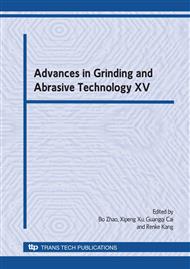p.455
p.461
p.467
p.472
p.477
p.482
p.487
p.492
p.497
Brittle-Ductile Transition in the Two-Dimensional Ultrasonic Vibration Grinding of Nanocomposite Ceramics
Abstract:
Based on impulse theories and indentation fracture mechanics, the motion model of the contact between abrasive particle and workpiece in workpiece two-dimension ultrasonic vibration grinding (WTDUVG) was analyzed, and the critical condition of ultrasonic vibration grinding brittle-ductile transition was analyzed theoretically, furthermore the critical cutting depths of a grain under different grinding conditions were obtained by Matlab programs. In this work, the ultrasonic vibration and conventional diamond grinding of Al2O3/ZrO2 nanoceramics were performed in order to investigate the effect of workpiece ultrasonic vibration on the brittle-ductile transition mechanism, the effect of grit size, worktable speed and grinding depth on the critical depth of cut were studied by grinding experiments. the micro-topography of the grinding surface was observed by AFM and SEM. Experiment indicated that only when the grinding depth less than critical grinding depth, ductile regime grinding of ceramics can be realized, the appropriate grinding parameter on surface finish are suggested.
Info:
Periodical:
Pages:
477-481
Citation:
Online since:
September 2009
Authors:
Price:
Сopyright:
© 2009 Trans Tech Publications Ltd. All Rights Reserved
Share:
Citation:


